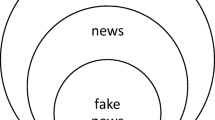Abstract
The growth and popularity of online media has made it the most important platform for collaboration and communication among its users. Given its tremendous growth, social reputation of an entity in online media plays an important role. This has led to users choosing artificial ways to gain social reputation by means of blackmarket services as the natural way to boost social reputation is time-consuming. We refer to such artificial ways of boosting social reputation as collusion. In this tutorial, we will comprehensively review recent developments in analyzing and detecting collusive entities on online media. First, we give an overview of the problem and motivate the need to detect these entities. Second, we survey the state-of-the-art models that range from designing feature-based methods to more complex models, such as using deep learning architectures and advanced graph concepts. Third, we detail the annotation guidelines, provide a description of tools/applications and explain the publicly available datasets. The tutorial concludes with a discussion of future trends.
Access this chapter
Tax calculation will be finalised at checkout
Purchases are for personal use only
Similar content being viewed by others
References
Politics and fake social media followers - lawsuit.org. https://lawsuit.org/politics-and-fake-social-media-followers/. Accessed 11 Aug 2020
Twitter: Platform manipulation and spam policy. https://help.twitter.com/en/rules-and-policies/platform-manipulation. Accessed 11 Aug 2020
Youtube: Fake engagement policy. https://tinyurl.com/yyvp68xh. Accessed 11 Aug 2020
Arora, U., Dutta, H.S., Joshi, B., Chetan, A., Chakraborty, T.: Analyzing and detecting collusive users involved in blackmarket retweeting activities. ACM Trans. Intell. Syst. Technol. 11(3), 1–24 (2020)
Arora, U., Paka, W.S., Chakraborty, T.: Multitask learning for blackmarket Tweet detection. In: Proceedings of the 2019 IEEE/ACM International Conference on Advances in Social Networks Analysis and Mining, pp. 127–130 (2019)
Castellini, J., Poggioni, V., Sorbi, G.: Fake Twitter followers detection by denoising autoencoder. In: Proceedings of the International Conference on Web Intelligence, pp. 195–202 (2017)
Dhawan, S., Gangireddy, S.C.R., Kumar, S., Chakraborty, T.: Spotting collective behaviour of online fraud groups in customer reviews (2019)
Dutta, H.S., Chakraborty, T.: Blackmarket-driven collusion among retweeters–analysis, detection and characterization. IEEE Trans. Inf. Forensics Secur. 15, 1935–1944 (2019)
Dutta, H.S., Chakraborty, T.: Blackmarket-driven collusion on online media: a survey. arXiv preprint arXiv:2008.13102 (2020)
Dutta, H.S., Chetan, A., Joshi, B., Chakraborty, T.: Retweet us, we will retweet you: spotting collusive retweeters involved in blackmarket services. In: ASONAM, pp. 242–249 (2018)
Dutta, H.S., Dutta, V.R., Adhikary, A., Chakraborty, T.: HawkesEye: detectingfake retweeters using Hawkes process and topic modeling. IEEE Trans. Inf. Forensics Secur. 15, 2667–2678 (2020)
Dutta, H.S., Jobanputra, M., Negi, H., Chakraborty, T.: Detecting and analyzing collusive entities on YouTube. arXiv preprint arXiv:2005.06243 (2020)
Gupta, S., Kumaraguru, P., Chakraborty, T.: MalReG: detecting and analyzing malicious retweeter groups. In: CODS-COMAD, pp. 61–69. ACM (2019)
Kumar, S., Cheng, J., Leskovec, J., Subrahmanian, V.: An army of me: sockpuppets in online discussion communities. In: Proceedings of the 26th International Conference on World Wide Web, pp. 857–866 (2017)
Liu, S., Hooi, B., Faloutsos, C.: HoloScope: topology-and-spike aware fraud detection. In: Proceedings of the 2017 ACM on Conference on Information and Knowledge Management, pp. 1539–1548 (2017)
Shah, N.: FLOCK: combating astroturfing on livestreaming platforms. In: WWW, pp. 1083–1091 (2017)
Shah, N., Lamba, H., Beutel, A., Faloutsos, C.: OEC: open-ended classification for future-proof link-fraud detection. CoRR abs/1704.01420 (2017). http://arxiv.org/abs/1704.01420
Streitfeld, D.: The Best Book Reviews Money Can Buy, Tulsa, Okla (2012). http://www.todroberts.com/USF/BookReviews_for_Sale.pdf
Wang, Z., Gu, S., Zhao, X., Xu, X.: Graph-based review spammer group detection. In: KAIS, pp. 1–27 (2018)
Author information
Authors and Affiliations
Corresponding author
Editor information
Editors and Affiliations
Rights and permissions
Copyright information
© 2020 Springer Nature Switzerland AG
About this paper
Cite this paper
Dutta, H.S., Chakraborty, T. (2020). Adversarial Collusion on the Web: State-of-the-Art and Future Directions. In: Bellatreche, L., Goyal, V., Fujita, H., Mondal, A., Reddy, P.K. (eds) Big Data Analytics. BDA 2020. Lecture Notes in Computer Science(), vol 12581. Springer, Cham. https://doi.org/10.1007/978-3-030-66665-1_15
Download citation
DOI: https://doi.org/10.1007/978-3-030-66665-1_15
Published:
Publisher Name: Springer, Cham
Print ISBN: 978-3-030-66664-4
Online ISBN: 978-3-030-66665-1
eBook Packages: Computer ScienceComputer Science (R0)




